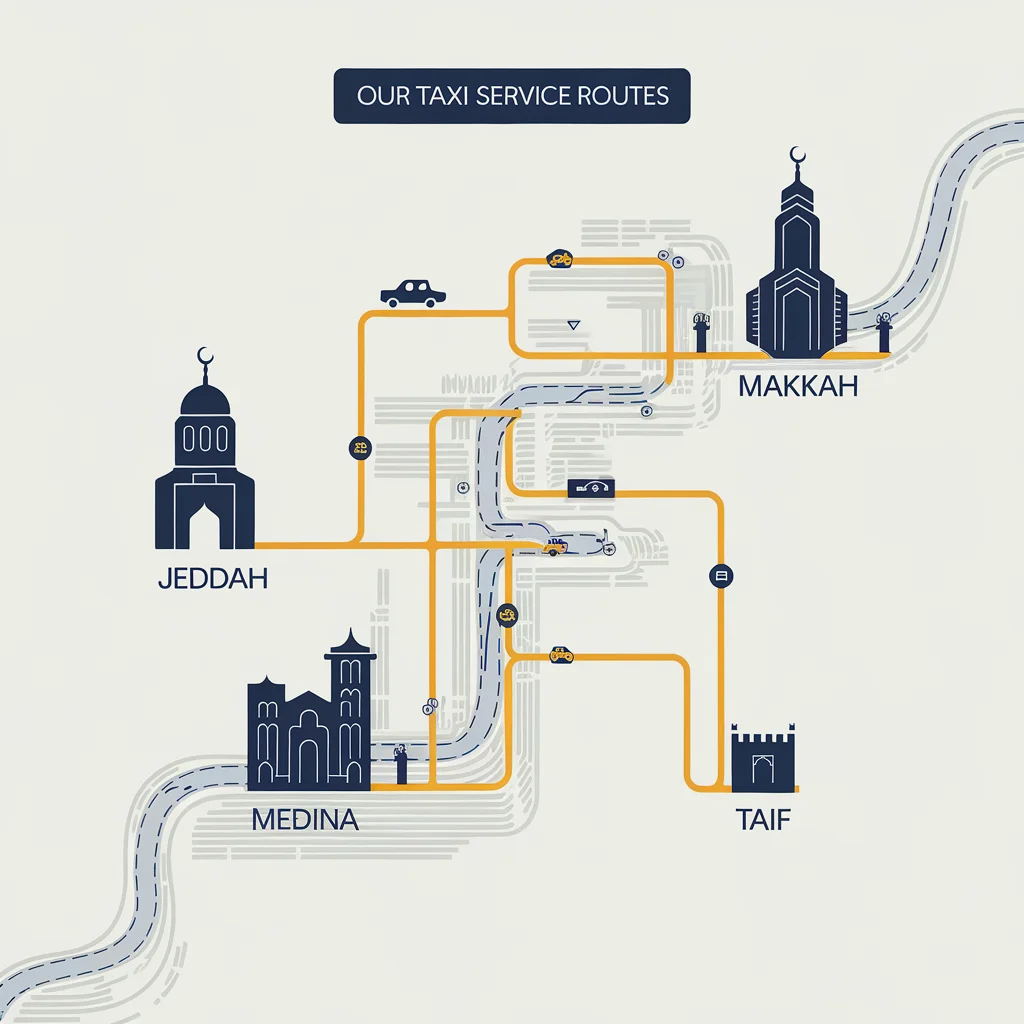No.1 Umrah Taxi Service Jeddah Airport to Makkah
Very Fast Booking Service
We are offering affordable umrah taxi services Jeddah to Makkah with latest models of cars with a driver.
Whether you’re a pilgrim on a sacred journey or a tourist exploring this historic city, we provide latest model cars with reasonable rent for your Makkah and Madina Tour. Our fleet of vehicles ensures you travel in comfort and confidence.
With our simple booking process and competitive rates, we provide these main taxi services:
Ride in Confort: Choose the Best Vehicle for Your umrah Trip
Need a reliable taxi service in Jeddah, Makkah, Madinah, or Taif City? Our private Umrah taxi service is perfect for families and individuals.
Best Rent A Car Jeddah Airport to Makkah & Medina
Rates List 2025 (Camry- H1 - Hiace) [ Low Rates ]
Arabic, English, Urdu and Hindi Speaking Drivers
| Routed | Camry | Starex / Staria | HIACE | |
| 1 | Jeddah Airport to Jeddah Hotel | 200 SR | 250 SR | 300 SR |
| 2 | Jeddah Airport to Makkah Hotel | 250 SR | 300 SR | 400 SR |
| 3 | Makkah Hotel to Jeddah Airport | 200 SR | 250 SR | 350 SR |
| 4 | Jeddah Airport to Medina Hotel | 450 SR | 500 SR | 600 SR |
| 5 | Makkah hotel to Madinah Airport | 450 SR | 500 SR | 600 SR |
| 6 | Makkah Hotel to Medina Hotel | 400 SR | 450 SR | 550 SR |
| 7 | Madinah Hotel to Jeddah Airport | 400 SR | 450 SR | 550 SR |
| 8 | Madinah Hotel to Makkah Hotel | 400 SR | 450 SR | 550 SR |
| 9 | Makkah Hotel to Taif & Return | 400 SR | 450 SR | 550 SR |
| 10 | Jeddah to Taif & Return Makkah | 700 SR | 1000 SR | 1200 SR |
| 11 | Madinah Airport to Madinah Hotel | 150 SR | 200 SR | 300 SR |
| 12 | Madinah Hotel to Madinah Airport | 120 SR | 150 SR | 250 SR |
| 13 | Makkah Ziyarat (Holy Places Visit) | 200 SR | 250 SR | 300 SR |
| 14 | Medina Ziyarat (Holy Places Visit) | 200 SR | 250 SR | 300 SR |
| 15 | Madina Ziyarat & Wadiya Jin | 350 SR | 400 SR | 450 SR |
| 16 | Makkah Hotel to Train Station | 100 SR | 150 SR | 200 SR |
| 17 | Makkah Train Station to Hotel | 100 SR | 150 SR | 200 SR |
| 18 | Medina Train Station to Hotel | 100 SR | 150 SR | 200 SR |
| 19 | Madina Hotel to Train Station | 100 SR | 150 SR | 200 SR |
| 20 | Masjid Aysha Meeqat | 100 SR | 150 SR | 300 SR |
| 21 | Masjid Jurana Meeqat | 150 SR | 200 SR | 400 SR |
| 22 | Rate Per Hour | 50 SR | 75 SR | 150 SR |
Rates List 2025 (GMC & COASTER) [ Low Rates ]
| Routed | GMC 2019 | GMC 2023-24 | Coaster | |
| 1 | Jeddah Airport to Jeddah Hotel | XXX SR | 400 SR | 500 SR |
| 2 | Jeddah Airport to Makkah Hotel | XXX SR | 550 SR | 800 SR |
| 3 | Makkah Hotel to Jeddah Airport | XXX SR | 500 SR | 700 SR |
| 4 | Jeddah Airport to Medina Hotel | XXX SR | 1000 SR | 1000 SR |
| 5 | Medina Hotel to Jeddah Airport | XXX SR | 1000 SR | 1000 SR |
| 6 | Makkah Hotel to Medina Hotel | XXX SR | 1000 SR | 1000 SR |
| 7 | Makkah Hotel to Madina Airport | XXX SR | 1000 SR | 1000 SR |
| 8 | Medina Hotel to Makkah Hotel | XXX SR | 1000 SR | 1000 SR |
| 9 | Makkah Hotel to Taif & Return | XXX SR | 1000 SR | 1000 SR |
| 10 | Jeddah to Taif & Return Makkah | XXX SR | 1500 SR | 1500 SR |
| 11 | Madina Airport to Madina Hotel | XXX SR | 400 SR | 400 SR |
| 12 | Madina Hotel to Madina Airport | XXX SR | 300 SR | 350 SR |
| 13 | Makkah Ziyarat (Holy Places) | XXX SR | 400 SR | 400 SR |
| 14 | Medina Ziyarat (Holy Places) | XXX SR | 400 SR | 400 SR |
| 15 | Madina Ziyarat & Wadiya Jin | XXX SR | 600 SR | 600 SR |
| 16 | Makkah Hotel to Train Station | XXX SR | 300 SR | 400 SR |
| 17 | Makkah Train Station to Hotel | XXX SR | 300 SR | 400 SR |
| 18 | Medina Train Station to Hotel | XXX SR | 300 SR | 400 SR |
| 19 | Madina Hotel to Train Station | XXX SR | 300 SR | 400 SR |
| 20 | Masjid Aysha Meeqat | XXX SR | 300 SR | 300 SR |
| 21 | Masjid Jurana Meeqat | XXX SR | 350 SR | 400 SR |
| 22 | Rate Per Hour | XXX SR | 150 SR | 250 SR |
Our Taxi Service Routes
Choose your Route and Book Comfortable Private Ride with Low Prices.

Any size group of people, any distance (Also jeddah Airport to makkah)
Our Umrah Taxi company is the first of its kind, offering the opportunity for immediate online booking for a wide range of vehicles with varied capacities based on the number of people in the group. Allow us to provide our renowned transportation service for your Umrah (jeddah to makkah), family or business trip, parties, airport transfers and corporate travel needs in Makkah or Madinah for the greatest ground transportation experience.


Google Reviews































